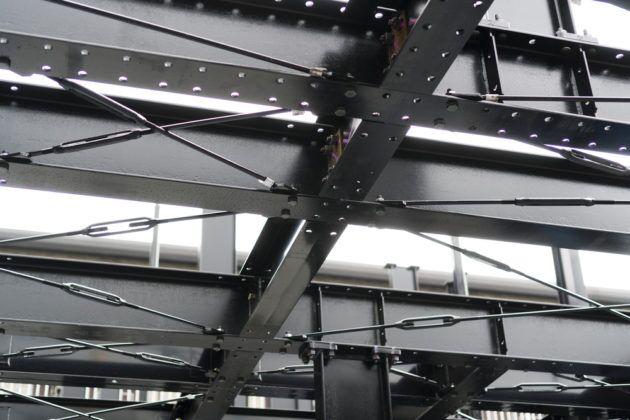
Seismic Retrofit of Steel Structures
According to a FEMA report, Earthquakes in the U.S. cause approximately $6.1 billion in building stock costs each year. Even if a company had the financial means to repair or rebuild after earthquake damage, this still presents a period of halting operations to make repairs. For residential structures, the stakes could be even higher, leaving people without homes. Also, in certain regions of the country, there’s the risk of this happening repeatedly. In order to avoid maximum damage in the seismic events, the construction energy is creating new innovations, including seismic retrofitting. Read on to learn what exactly seismic retrofit is and how it applies in the steel industry.
Table of Contents
What Is Seismic Retrofit?
So, what exactly is seismic retrofit? While many new construction buildings in earthquake zones have the benefit of our current knowledge of construction, many existing buildings don’t. These are among the most vulnerable to heavy damage or even collapse if an earthquake was to happen. This is the process of seismic retrofitting: making modifications to existing buildings in order to make them more earthquake resistant.
While seismic retrofitting costs can represent a notable cost, especially for larger steel structures, depending on where you live or do business, it could be well worth the money. There are three main benefits we should talk about here:
Immediate damage prevention:
If anyone was in the building at the time of the seismic event, minimizing the impact on the structure will lower the chance of them being injured. The same thing applies to any damaged stock or equipment.
Long-term investment protection:
If you are running a business/industrial company and own the building, you need to protect it like any other asset. Seismic retrofitting is an essential addition in earthquake-prone areas.
Legal liability:
If the other structures in, say, an industrial park were retrofitted, and yours wasn’t, and a falling piece of debris during an earthquake injured someone, you may be at legal risk. Retrofitting is about protecting your company in a variety of different ways.
So, how exactly does seismic retrofit work? When you first start working with a contractor that has experience in this area, they will visit the structure and assess it. How long this takes is naturally dependent on the size of the structure. After the inspection, the contractor explains what areas of vulnerability there are and what issues are present.
After this, the actual work of retrofitting begins. What exactly this entails is different for each structure. For example, bolts or plates to anchor the framing to the foundation are common, if not already there. If there are unreinforced cripple walls present, plywood shear walls or panels will be installed to support that wall. When the work is done, the contractor will replace any removed siding/drywall before reconstructing the walls. Note that there are no codes on the books for seismic retrofit, so you want to have a concrete plan to show your customers why they should trust your work.
Implementing Seismic Retrofit In The Steel World
Studies show that unreinforced masonry and concrete walls/structures are generally the biggest areas that need retrofitting. However, that doesn’t mean that other structures are completely safe. Major natural disasters like the 1994 Northridge earthquake and the 1989 Loma Prieta earthquake showed that legacy steel structures could still fail in a major seismic event. Even if failure didn’t happen, there could be fracturing; as a result, leading to issues. As a result, people who own steel structures should give heavy thought to seismic retrofit.
This is particularly important for steel frame buildings made before the mid-1990s. Buildings in this category can develop a brittle fracturing of the steel frames at the welded/riveted joints between the columns and beams. If this was to happen, the connections could be damaged or broken. In turn, this increases the risk of localized collapse.
There are a few options on hand to use for steel seismic retrofit, including:
— Strengthening local connections. There are a few options here, using either chevron bracing or beam-to-column connections.
— Strengthening the steel moment frames with dampers or a lateral system.
— Implementing self-centering systems when steel moment frames are not available or too costly.
— Controlled rocking systems may be applicable for steel truss bridges.
With these options on the table, how can you incorporate seismic retrofit into your steel business? As mentioned before, it doesn’t have a concrete code to follow, which means you need to have proper expertise before you start offering this. Because seismic retrofit is a bit of a specialized area, you may not be able to get started until you hire someone with experience in this area. Complicating, this is the fact that there are different forms of steel retrofit, as seen above. Your team may need to master several different retrofit types to service a wide set of steel clients.
Final Thoughts on Seismic Retrofit of Steel Structures
In many regions, earthquake retrofit is an essential service for steel companies to provide for their clients. In some cases, it may even be a regulatory matter. As a result, having a proper understanding of seismic retrofit techniques is essential for many companies to master. With that said, whenever you take on a new service or skill in your company, a cost analysis needs to be performed. Is the business you bring in going to be worth the labor and time costs that it takes to learn and practice these techniques?
You can only figure this out with an accurate, real-time understanding of your operations and finances. This is only possible with project management software like eSUB. Figure out how much it costs your company to practice retrofitting to find out if it makes sense for your business, as well as what an appropriate price would be to keep things profitable in your local market.
